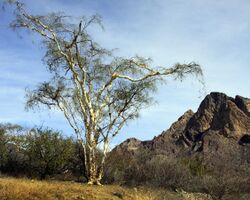Biology:Mariosousa willardiana
| Mariosousa willardiana | |
|---|---|

| |
| Scientific classification | |
| Kingdom: | |
| (unranked): | |
| (unranked): | |
| (unranked): | |
| Order: | |
| Family: | |
| Genus: | |
| Species: | M. willardiana
|
| Binomial name | |
| Mariosousa willardiana (Rose) Seigler & Ebinger[1]
| |
| Synonyms | |
| |
Mariosousa willardiana, also called Palo Blanco tree,[2] palo liso, guinola[3] and Willard Acacia, is a normally evergreen plant in the genus Mariosousa native to Mexico. The Spanish common name translates into 'white stick', defining its peeling white bark. A compound called Willardiine, that acts as an agonist in glutamate receptors, can be isolated from M. willardiana.[4][5]
Description
It can grow 10–20 ft or more with a spread of 1/3 to 2/3 the height. It is a very slender tree with few branches as well as leaves. The petiolar-rachis is characteristically long and functions as a cladophyll. it has a white or yellow-colored peeling off bark. The leaves have 5-6 leaflets in the end. It may drop leaves in autumn and winter. The flowers are like catkins, rod or bottle-brush-like, white or light yellow in color. The pods are multichambered, and 3-4 in long specimens.[6] The flowers occur in pale yellow spikes.[7]
Distribution and habitat
The plant is endemic to Sonora (Sonoran desert), Mexico. It prefers rocky bajdas, slopes and arroyos from 0 to 2,000 feet elevation.[8]
See also
- Sonora desert
References
- ↑ "Mariosousa, a New Segregate Genus from Acacia s.l. (Fabaceae, Mimosoideae) from Central and North America.". Novon 16 (3): 413–420. 2006. doi:10.3417/1055-3177(2006)16[413:MANSGF2.0.CO;2]. http://www.bioone.org/doi/abs/10.3417/1055-3177%282006%2916%5B413%3AMANSGF%5D2.0.CO%3B2.
- ↑ Phillips, S. J.; Patricia Wentworth Comus (2000) (PDF). A natural history of the Sonoran Desert. Arizona: Arizona-Sonora Desert Museum Press. p. 230. ISBN 0-520-21980-5. https://books.google.com/books?id=Lb5I0tcnYNkC&pg=PA230&dq=Acacia+willardiana&hl=en&ei=3sx9ToCAO8H3rQeXq7TtDw&sa=X&oi=book_result&ct=result&resnum=7&ved=0CE8Q6AEwBg#v=onepage&q&f=false.
- ↑ Dimmitt, M. A.. "Acacia willardiana". Arizona-Sonora Desert Museum. ASDM Sonoran Desert Museum Digital Library. http://www.desertmuseumdigitallibrary.org/public/detail.php?id=ASDM09608&sp=Acacia%20willardiana.
- ↑ Klaassen, C. D.; John Barr Watkins (2010). "Toxic Agents" (PDF). Casarett and Doull's essentials of toxicology. USA: McGraw-Hill Prof Med/Tech. p. 374. ISBN 978-0-07-176651-7. https://books.google.com/books?id=lqE5RW-nvhsC&pg=PA374&dq=Acacia+willardiana&hl=en&ei=sdN9TuaOBNHHrQfOv5HODw&sa=X&oi=book_result&ct=result&resnum=1&ved=0CCwQ6AEwADgK#v=onepage&q=Acacia%20willardiana&f=false.
- ↑ Atta-ur- Rahman (2000). "Interference of Alkaloids" (PDF). Bioactive Natural Products (Part B), Part 2. Amsterdam: Alsevier Science B. V.. p. 72. https://books.google.com/books?id=tWEFrc7EfRgC&pg=PA72&dq=Acacia+willardiana&hl=en&ei=sdN9TuaOBNHHrQfOv5HODw&sa=X&oi=book_result&ct=result&resnum=3&ved=0CDgQ6AEwAjgK#v=onepage&q=Acacia%20willardiana&f=false.
- ↑ Moore, Tony. "Acacia willardia, Palo blanco, Fabaceae Family". Government of Arizona. http://ag.arizona.edu/pima/gardening/aridplants/Acacia_willardiana.html.
- ↑ Jaeger, E. C. (1957) (PDF). The North American deserts. California: Stanford University Press. p. 256. ISBN 0-8047-0498-8. https://books.google.com/books?id=pB3mbO2iTucC&pg=PA256&dq=Acacia+willardiana&hl=en&ei=3sx9ToCAO8H3rQeXq7TtDw&sa=X&oi=book_result&ct=result&resnum=8&ved=0CFUQ6AEwBw#v=onepage&q=Acacia%20willardiana&f=false.
- ↑ {{citation | mode = cs1 | title = Mariosousa willardiana | work = Germplasm Resources Information Network (GRIN) | url = | publisher = [[Organization:Agricultural Research ServAgricultural Research Service (ARS), United States Department of Agriculture (USDA) | access-date = 23 January 2018 }}
| Wikimedia Commons has media related to Mariosousa willardiana. |
Wikidata ☰ Q4671022 entry



